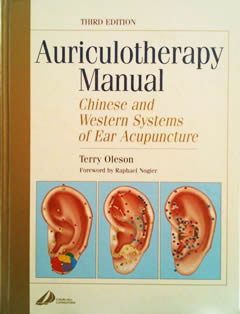Auriculotherapy Manual
- Auriculotherapy
Chinese and Western Systems of Ear Acupuncture
Autor: Terry Oleson; 2003, 359 páginas
“Um livro completo, descreve a Auriculoterapia chinesa e francesa (na qual ele chama de, respectivamente oriental e ocidental) com muitos detalhes e coisas que nunca vi em nenhum livro nacional e que, quando testei funcionaram muito bem. Respeitando uma tendência que também concordo, seus protocolos são baseados na escola chinesa e francesa, ou seja, o ideal é a soma das escolas e não a disputa entre elas. O livro está em inglês.”
Chapter 1 – Overview and history of auriculotherapy
1.1 Introduction to auriculotherapy
1.2 Healthcare practitioners using auriculotherapy
1.3 Historical overview of auriculotherapy
1.4 Ear acupuncture developments in China
1.5 Auriculotherapy and auricular medicine in the West
1.6 Comparison of ear acupuncture to body acupuncture
Chapter 2 – Theoretical perspectives of auriculotherapy
2.1 Micro-acupuncture systems
2.2 Traditional Oriental medicine and qi energy
2.3 Ayurvedic medicine, yoga and prana energy
2.4 Holographic model of microsystems
2.5 Neurophysiology of pain and pain inhibition
2.6 Endorphin release by auricular acupuncture
2.7 Embryological perspective of auriculotherapy
2.8 Nogier phases of auricular medicine
2.9 Integrating alternative perspectives of auriculotherapy
Chapter 3 Anatomy of the auricle
3.1 The spiral of life
3.2 Neuro-embryological innervations of the external ear
3.3 Anatomical views of the external ear
3.4 Depth view of the external ear
3.5 Anatomical regions of the external ear
3.6 Anatomical regions of the posterior ear
3.7 Curving contours of the antihelix and antitragus
3.8 Somatotopic correspondences to auricular regions
3.9 Determination of auricular landmarks
3.10 Anatomical relationships of auricular landmarks
3.11 Standard dimensions of auricular landmarks
Chapter 4 – Auricular Zones
4.1 Overview of the auricular zone system
4.2 International standardization of auricular nomenclature
4.3 Anatomical identification of auricular zones
4.4 Somatotopic correspondences to auricular zones
4.5 Representation of Nogier phases in auricular zones
4.6 Microsystem points represented in auricular zones
Chapter 5 – Auricular diagnosis procedures
5.1 Visual observation of skin surface changes
5.2 Tactile palpation of auricular tenderness
5.3 Electrical detection of ear reflex points
5.4 Nogier vascular autonomic signal (N-VAS)
5.5 Auricular diagnosis guidelines
5.6 Assessment of oscillation and laterality disorders
5.7 Obstructions from toxic scars and dental foci
5.8 Scientific investigations of auricular diagnosis
Chapter 6 – Auriculotherapy treatment procedures
6.1 Auricular acupressure
6.2 Ear acupuncture needling techniques
6.3 Auricular electroacupunture stimulation (AES)
6.4 Transcutaneous auricular stimulation (TAS)
6.5 Auricular medicine
6.6 Seven frequency zones
6.7 Semipermanent auricular procedures
6.8 Selection of auricular acupoints for treatment
6.9 Tonification and sedation in auriculotherapy
6.10 Relationship of yin organs to ear acupoints
6.11 Geometric ear points
6.12 Inverse and contrary relationships of the ear and body
6.13 Precautions associated with auriculotherapy
6.14 Hindrances of treatment success
6.15 Overall guidelines for auriculotherapy treatments
Chapter 7 – Somatotopic representations on the ear
7.1 Master points on the ear
7.2 Auricular representation of the musculoskeletal system
7.3 Auricular representation of internal visceral organs
7.4 Auricular representation of endocrine glands
7.5 Auricular representation of the nervous system
7.6 Auricular representation of functional conditions
Chapter 8 – Clinical case studies of auriculotherapy
8.1 Relief of nausea
8.2 Myofascial trigger points
8.3 Back pain
8.4 Peripheral neuropathy and neuralgia
8.5 Weight control
8.6 NADA addiction protocol
8.7 Alternative addiction protocols
8.8 International Consensus Conference on Acupuncture, Auriculotherapy, and Auricular Medicine (ICCAAAM)
8.9 Auriculotherapy Certification Institute
Chapter 9 – Auriculotherapy treatment protocols
9.1 Addictive behaviors and drug detoxification
9.2 Acute and chronic pain in upper and lower limbs
9.3 Back pain and body aches
9.4 Head and neck pain
9.5 Dental pain
9.6 Neurological disorders
9.7 Stress-related disorders
9.8 Psychological disorders
9.9 Eyesight disorders
9.10 Hearing disorders
9.11 Nose and throat disorders
9.12 Skin and hair disorders
9.13 Heart and circulatory disorders
9.14 Lung and respiratory disorders
9.15 Gastrointestinal and digestive disorders
9.16 Kidney and urinary disorders
9.17 Abdominal organ disorders
9.18 Gynecological and menstrual disorders
9.19 Glandular disorders and sexual dysfunctions
9.20 Illnesses, inflammations and allergies


